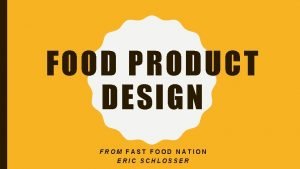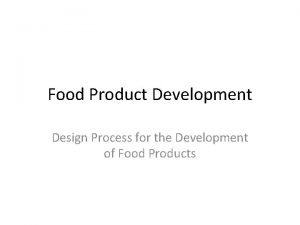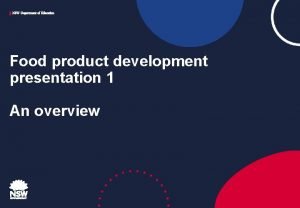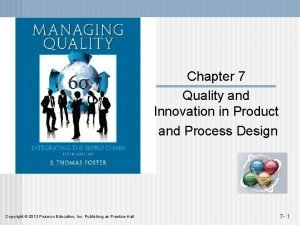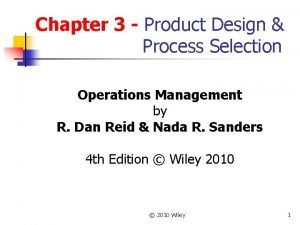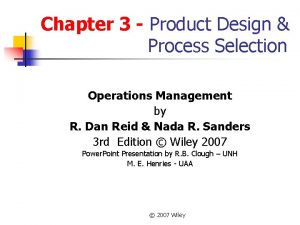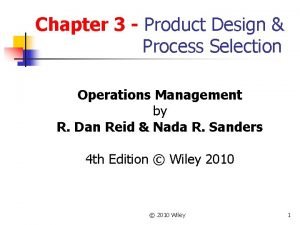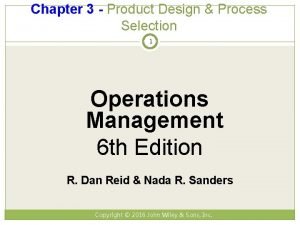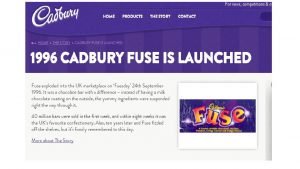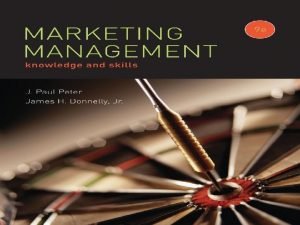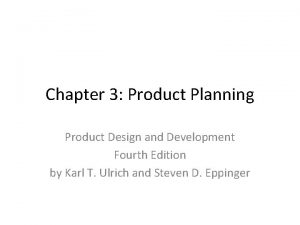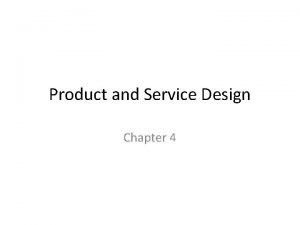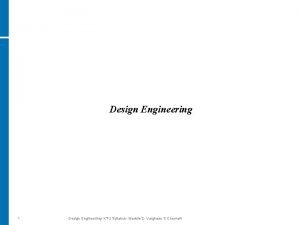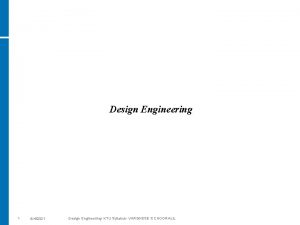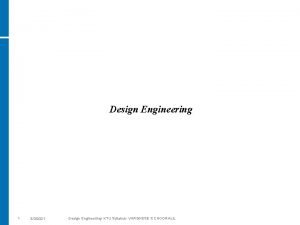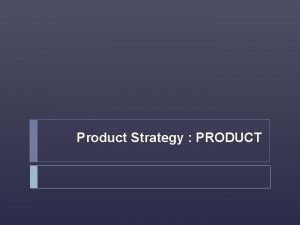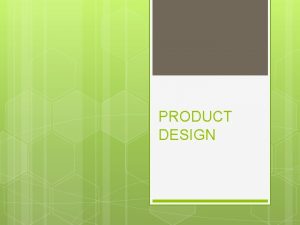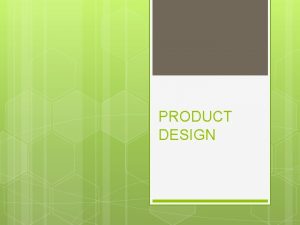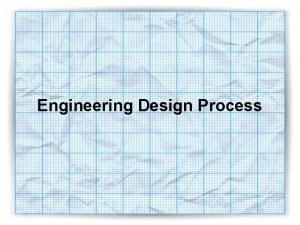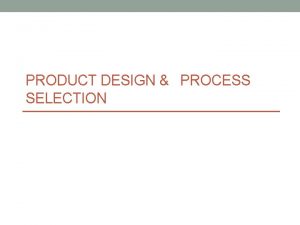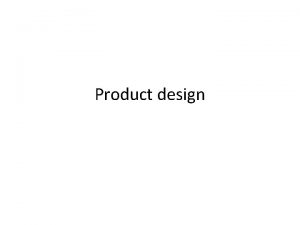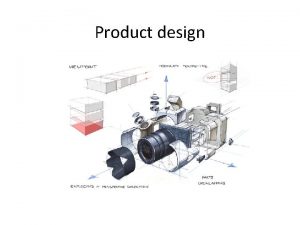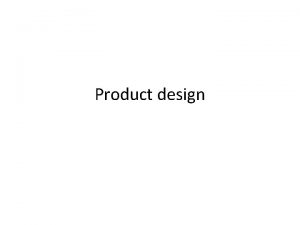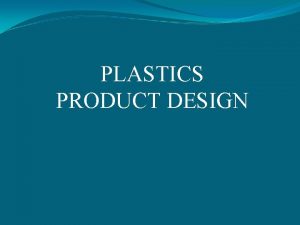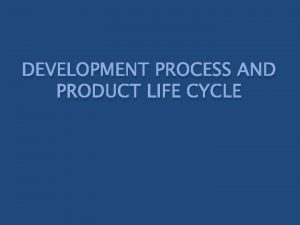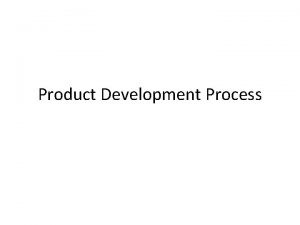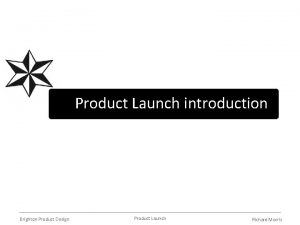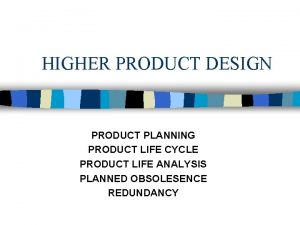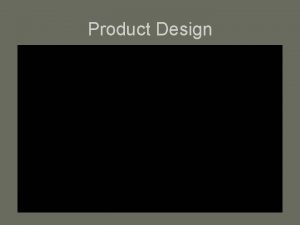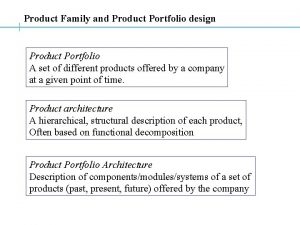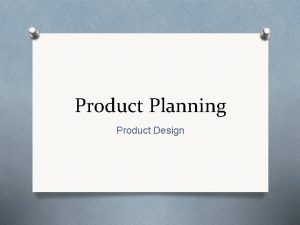Food Product Development Design Process for the Development




























































- Slides: 60

Food Product Development Design Process for the Development of Food Products

Topics • • Introduction Design brief Market research Design specification Idea generation Feasibility study Development of prototype Evaluation of a food product / design idea 2

INTRODUCTION 3

Introduction Product Development: The overall process of strategy, organisation, concept generation, product and marketing plan creation and evaluation, and commercialisation of a new product. The Product Development and Management Association The PDMA Hand Book 1 st Edition. 4

Phases in Product Development • New food product development can be divided into several phases • There is no common agreement on the number, order, or names of the phases • Practically, the phases overlap and are concurrent 5

Phases in Product Development Earle (2009) describes the development process with four main stages: Stage 1 Development of a business strategy that describes the project Stage 2 A research and development phase of the project including the design for manufacturing process Stage 3 programmes marketing, Development for of production, and quality assurance Stage 4 Organisation of production and distribution for the launch and an analysis of the launch sales data 6

Design Process Design brief Identify design problems Identify user group Market research Collect and analyse information of customers’ needs Design specification Evaluation of a Development of food product / prototype Idea generation Feasibility study design idea Devise the intended purpose of a product Study the internal and external factors Issues affecting the development of a new product Generating design proposals Evaluation or analysis of the possible potentials of the proposed food product idea Make the first real product as a specimen for trial and market research Evaluation of a prototype sensory evaluation Modifying food products 7

DESIGN BRIEF 8

Identifying Design Problems • Identify a gap in the current market to see if there is a need of a new product that will satisfy customers’ need • Identify a user group or target market 9

Ways to Identify the Gap in the Market Reading newspaper and magazine articles Looking at trends in the media Carrying out interviews and questionnaires Looking at what competitors are producing Reading recipe books Identifying the gap Carrying out supermarket surveys Looking at what products already exist and thinking how a new range could be developed Consulting government research 10

Examples of Gaps in the Market From a manufacturer’s research, it is seen that snacks are mainly youthful and fun or mature and healthy. A need of youthful and healthy snacks is lacking. Summer desserts are selling well, a food retailer wants to develop their range. After looking at what is available in other supermarkets, a food retailer has decided that their range of single portion cook-chill meals needs developing. A food retailer has decided to reflect the “ 2 plus 3 a Day” campaign by introducing a new range of fruit desserts. 11

Identifying the User Group or Intended Target Market • The purpose is to match the product to customers’ need, hence satisfying customer by producing a successful marketable product • The user group or intended target market is the group of people whom a product is aimed at 12

Identifying the User Group or Intended Target Market Vegetarians Parents Couples Teenagers Examples of user group or intended target market Singleperson household Toddlers Elderly 13

Identifying the User Group or Intended Target Market Reasons for identifying the customers • Views of the group are considered • Dietary needs can be taken into account • Eating habits are considered • Preferred cooking method, e. g. microwavable dinners for college students • Appropriate portion size • Packaging and marketing of the product is focused towards the user group • Cost is appropriate for the targeted customers 14

Developing a Design Brief • A design brief is a short statement that outlines the problem to be solved. A design brief is a • The design brief may state: short statement that outlines the - the product must be marketable problem to be - the type of product to be developed solved. - the user group or intended target market - the occasion or place which the product is used / consumed - the cost 15

Developing a Design Brief Example of a design brief: Design and make a marketable hand-held savoury snack for vegetarian adults at a cost of HK$10. 16

MARKET RESEARCH 17

Purpose of Conducting Research To find out the opinions of the intended target market To find out about types of products which are already in the market To find out market trends e. g. shopping/eating habits Why carry out research? To ensure time and money are not wasted on a product no one will want To find out which products are marketable using sales figures 18

Market Research • A process of collecting and analysing information of customers’ needs • Helps a company to create its business plan and to find out if the new product is marketable • Can be done by research companies • Two types of market research: primary research and secondary research 19

Two Types of Market Research Primary research sources Secondary research sources • Information that is obtained directly from interviews, questionnaires and observations or from sensory testing • Information that has been collected by other people, for instance, from books or newspapers 20

Two Types of Market Research Primary research Secondary research Source of information • Focus groups, surveys, field tests, interviews or observation • Local libraries, web sites, books, business publications, magazines and newspapers Purpose • Gain information from a company’s target group of customers for a particular new products • Find out market information for extending business into new markets, adding new services or product lines Accuracy and specificity • Tailor-made for the company’s particular needs • More accurate and specific for the target market of the company • Second-hand information, less accurate, useful and specific, which may not suit the particular need of the company Expense • More expensive • Less expensive Source: Food Science and Technology Strand (n. d. ). Learning and Teaching References, Technology and Living (Secondary 4 -6), 13 Food Product Development. Hong Kong Education Bureau. 21

Methods of Research 1. Questionnaires • A set of questions carefully designed to obtain the opinions of people • Can be done by research companies • Can be carried out in a variety of ways, e. g. : - over the telephone in supermarket sent through the post on the street 22

Methods of Research 2. Evaluating existing products • A food manufacturer may evaluate their own existing products or those of their competitors • Can be done by carrying out sensory evaluation • Reasons for evaluating sensory evaluation: existing products: looking at, smelling - to get ideas for new products - to improve existing products and tasting a food for product development. 23

Methods of Research 3. Supermarket surveys • Visits to supermarkets are useful to find out: - what products competitors are producing and selling the costs of similar products how well a product is selling information about the market trends, e. g. eating and shopping habits of people 24

Questionnaires • A questionnaire should be designed for extracting specific information from people about the qualities they would like to see in a new product • Properly introduce the questionnaire, so that it allows the public to: - focus clearly on theme of the questionnaire - feel involved from the start, so a more satisfactory response is given - understand the purpose of the questionnaire Fehners, V. , Simpson, M. , & Monks, B. (2011). Food technology. London: Hodder Education. 25

Questionnaires General rules of designing questionnaires: • Questions are clear and easy to understand answer • Easy to collate the results using graphs, tables, tally charts, pie charts, etc. • Data are easy to analyse and draw conclusion from • Questionnaire should not be too long that may cause irritation • Make sure that all questions will lead to useful answers • Information and Communication Technology (ICT) is often used to design and analyse the questionnaire • After obtaining results, summarise the findings Fehners, V. , Simpson, M. , & Monks, B. (2011). Food technology. London: Hodder Education. 26

Questionnaires Different types of questions can be used: 1. Closed questions • can be a very quick way of finding out specific information • provide a yes/no type response or offer limited choice of answers, e. g. Do you like the flavour of the chocolate? □ Yes □ No Fehners, V. , Simpson, M. , & Monks, B. (2011). Food technology. London: Hodder Education. 27

Questionnaires 2. Multiple choice • offers a range of responses for the respondents to choose from, e. g. Which flavour do you prefer? □ Chocolate □ Lemon □ Coffee □ Ginger Fehners, V. , Simpson, M. , & Monks, B. (2011). Food technology. London: Hodder Education. 28

Questionnaires 3. Ordered choice • sometimes it is useful for the respondents to rank a set of options by numbering them in order, e. g. Place in order of preference the following flavourings. Indicate by numbering from 1 to 4 in order, where 1 is the most preferred. □ Chocolate □ Lemon □ Coffee □ Ginger Fehners, V. , Simpson, M. , & Monks, B. (2011). Food technology. London: Hodder Education. 29

Questionnaires 4. Open-ended questions • can produce a wide variety of responses that take a long time to interpret and put into categories • useful for finding out about attitudes and opinions, e. g. 1. What do you like about biscuits? 2. What flavour would you like the biscuit to be and why? Fehners, V. , Simpson, M. , & Monks, B. (2011). Food technology. London: Hodder Education. 30

DESIGN SPECIFICATION 31

The Intended Purpose of a Product • The product development team should have a clear understanding of the product’s intended purpose • Examples: The product development team is a group of people who are responsible for creating new food products. - The intended purpose of a cereal bar is to provide a quick, hand-held and easy to eat snack. - The intended purpose of a single frozen meal is to provide a quick and convenient meal for one person. 32

Issues Affecting the Development of a New Product Consider the issues that might affect product development, e. g. : 1. Method of production 2. Environmental issues 3. Cost issues 4. Ethical issues 5. Social issues 6. Cultural issues 33

Issues Affecting the Development of a New Product Method of production Environmental issues Cost issues • Can be manufactured with existing machinery? • Budget for buying and installing new machinery? • Packaging materials include recycled or recyclable materials? • Budget available to produce the new product? • Consider food cost, production cost, distribution cost, and profit Ethical issues • Do the products include any genetically modified foods? Social issues • Is there demographic differences in different areas? E. g. retailers in a wealthy district make more profits on expensive items. Cultural issues • Are the ingredients in the products suitable for all cultures, including different religions? 34

Writing a Design Specification • A design specification is usually written as a series of bullet points or a numbered list. • It clearly states the general details Design of the product to be developed. specification: the qualities a product should • It is a checklist for evaluation have. throughout the development of a product and when testing the final product. 35

Writing a Design Specification A design specification may include the following: • Type and purpose of product • Requirements of target group • Nutritional information • Types of ingredients to be used • Portion size • Shape / Flavour / Colour • Price range of the product • Packaging • Storage and shelf life considerations • Environmental / Ethical / Social / Cultural issues 36

Writing a Design Specification Example of a design specification: Low-fat, less than 3 g per 100 g portion Hand-held Priced between HK$10 and HK$15 Savoury Use existing packaging materials Design specification Snack size Tasty Suitable for manufacture in quantity 37

IDEA GENERATION 38

Idea Generation • A process of creating ideas or concepts for developing new products; also called “concept generation” • By studying external and internal factors as well as the trends of the marketplace, find out ways of either improving or modifying the current products Source: Food Science and Technology Strand (n. d. ). Learning and Teaching References, Technology and Living (Secondary 4 -6), 13 Food Product Development. Hong Kong Education Bureau. 39

Idea Generation Recipe books Web sites Existing products Where do ideas come from? Analysis of research information Ideas from chefs on the television 40

Idea Generation • Can be done by brainstorming or mind map Brainstorming • A useful tool for generating ideas • A problem solving activity by a group of people trying to find out a solution to a specific problem Source: Food Science and Technology Strand (n. d. ). Learning and Teaching References, Technology and Living (Secondary 4 -6), 13 Food Product Development. Hong Kong Education Bureau. 41

Idea Generation Mind map • A diagram used to note down words, ideas, tasks or other items linked to and arranged radially around a central key word or idea • A useful tool in the process of brainstorming • The schematic structure of information may aid the recall of existing memories Source: Food Science and Technology Strand (n. d. ). Learning and Teaching References, Technology and Living (Secondary 4 -6), 13 Food Product Development. Hong Kong Education Bureau. 42

e fla v Ros a ys hr em h nt Example of a mind map: um C Floral flavours Suitable, not easy to block the esophagus ur vo a l f Use sweeteners available in food law to replace sugar our Idea Generation Candy Different flavours Low sugar Safe to eat Healthy for elderly Source: Food Science and Technology Strand (n. d. ). Learning and Teaching References, Technology and Living (Secondary 4 -6), 13 Food Product Development. Hong Kong Education Bureau. 43

Generating Design Proposals • A product development team communicates their ideas to other people by: - annotated sketches - mood boards - photographs - making up samples 44

Annotated sketches What could an annotated sketch include? • Size/Weight • Shape • Ingredients to be used • Finishes • Colours • Method of production • Nutritional information • Packaging (optional) 45

Annotated sketches 46

FEASIBILITY STUDY 47

Feasibility Study • An evaluation or analysis of the possible potentials of the proposed food product idea • Provides information to assist decision-makers to determine whether the idea is feasible or the development process has to be stopped at this stage • Based on an extensive research and analysis on financial and operational impact 48

Feasibility Study Questions to be Answered During a Feasibility Study Can the product be produced by existing facilities? Are new facilities needed? Does the manufacturing process have to be invented for the new product? If yes, consider extra resources. Are the required raw and packaging materials available? Are there any other operational considerations particular to the project? What is the capital of the project? Is the price acceptable by the customers? Is the selling price of the product competitive enough? 49

DEVELOPMENT OF PROTOTYPE 50

Development of Prototype • After justifying the idea, the product can be made on a small scale • The first real product is the prototype or sample • A prototype is an example or specimen for trail and market research • Recipes are adapted and modified A prototype is the first of its so that the product meets the kind produced. requirements stated in the product specifications 51

Development of Prototype When making the product, keep accurate records of: • a list of ingredients and quantities • costing of the ingredients used • preparation and processing procedures • preparation and processing time used, e. g. cooking time shape / size / weight of the finished product • cooking temperature (for baked products) • Special equipment needed 52

EVALUATION OF A FOOD PRODUCT / DESIGN IDEA 53

Evaluation of a Prototype • Evaluation is ongoing throughout the development of a food product • Once the product development team is satisfied with a prototype, they can begin to ask others to evaluate it • The evaluation involves: - looking at the product - smelling the product - tasting the product 54

Evaluation of a Prototype Simple flow chart of sensory evaluation stage Concept Develop samples Sensory evaluation (sensory testing) Reject Accept 55

Sensory Evaluation Who carries out the sensory evaluation? • People who work in the food factory - can provide quick feedback • General public - more detailed feedback - often the same group of people who have been trained and can represent the user group or intended target market 56

Sensory Evaluation Why carry out sensory evaluation? • To test and develop new products • To improve existing products • To reduce costs, e. g. by changing the cost of a product without changing the taste, texture or appearance • To allow changes to be made to products before they go into production • To enable the target market to try the product • To check the quality of the product during production • To promote a product, e. g. tasting at supermarkets 57

Modifying Food Products • After sensory evaluation has taken place, product development team can consolidate results and if necessary, modify the products • Modification that can be made to a product: - the ingredients used proportions of ingredients used the cooking method used presentation of the product, e. g. shape assembling of the product, e. g. layering differently 58

Modifying Food Products To fit packaging design requirements To make the product suitable for different dietary and cultural needs To improve the nutritional content To change the flavour Reasons to modify food products To improve the final appearance of a product To alter the colour To alter the texture To alter the shape To reduce costs 59

References • Earle, M. D. (2009). Food product development. Boca Raton, FL: CRC Press. • Fehners, V. , Simpson, M. , & Monks, B. (2011). Food technology. London: Hodder Education. • Food Science and Technology Strand (n. d. ). Learning and Teaching References, Technology and Living (Secondary 46), 13 Food Product Development. Hong Kong Education Bureau. • Hong Kong Examinations and Assessment Authority (2017) . Technology and Living School-based Assessment Food Science and Technology Strand Guidelines on Project for Food Product Development (2017). Hong Kong: Hong Kong Examinations and Assessment authority • Winson, A. (2003). Revise for OCR GCSE food technology. Oxford: Heinemann. 60
 Fast food nation summary
Fast food nation summary Food product design and development
Food product design and development Product life cycle kotler
Product life cycle kotler Unit 2 food food food
Unit 2 food food food Eltonian pyramid
Eltonian pyramid Examples of me too food products
Examples of me too food products Product and process design in operations management
Product and process design in operations management Quality and innovation in product and process design
Quality and innovation in product and process design Process selection in operations management
Process selection in operations management Product design and process selection
Product design and process selection Process selection in operations management
Process selection in operations management Product design and process selection
Product design and process selection New product development idea generation
New product development idea generation Product planning and development
Product planning and development Ivd product development process
Ivd product development process Product planning and development
Product planning and development Design that results in products or services
Design that results in products or services Design and engineering ktu syllabus
Design and engineering ktu syllabus Design engineering ktu
Design engineering ktu Design engineering ktu syllabus
Design engineering ktu syllabus Fspos
Fspos Typiska novell drag
Typiska novell drag Tack för att ni lyssnade bild
Tack för att ni lyssnade bild Ekologiskt fotavtryck
Ekologiskt fotavtryck Shingelfrisyren
Shingelfrisyren En lathund för arbete med kontinuitetshantering
En lathund för arbete med kontinuitetshantering Adressändring ideell förening
Adressändring ideell förening Personlig tidbok fylla i
Personlig tidbok fylla i Anatomi organ reproduksi
Anatomi organ reproduksi Vad är densitet
Vad är densitet Datorkunskap för nybörjare
Datorkunskap för nybörjare Stig kerman
Stig kerman Hur skriver man en debattartikel
Hur skriver man en debattartikel Delegerande ledarstil
Delegerande ledarstil Nyckelkompetenser för livslångt lärande
Nyckelkompetenser för livslångt lärande Påbyggnader för flakfordon
Påbyggnader för flakfordon Kraft per area
Kraft per area Svenskt ramverk för digital samverkan
Svenskt ramverk för digital samverkan Urban torhamn
Urban torhamn Presentera för publik crossboss
Presentera för publik crossboss Teckenspråk minoritetsspråk argument
Teckenspråk minoritetsspråk argument Bat mitza
Bat mitza Treserva lathund
Treserva lathund Luftstrupen för medicinare
Luftstrupen för medicinare Claes martinsson
Claes martinsson Centrum för kunskap och säkerhet
Centrum för kunskap och säkerhet Lågenergihus nyproduktion
Lågenergihus nyproduktion Bra mat för unga idrottare
Bra mat för unga idrottare Verktyg för automatisering av utbetalningar
Verktyg för automatisering av utbetalningar Rutin för avvikelsehantering
Rutin för avvikelsehantering Smärtskolan kunskap för livet
Smärtskolan kunskap för livet Ministerstyre för och nackdelar
Ministerstyre för och nackdelar Tack för att ni har lyssnat
Tack för att ni har lyssnat Referatmarkering
Referatmarkering Redogör för vad psykologi är
Redogör för vad psykologi är Stål för stötfångarsystem
Stål för stötfångarsystem Tack för att ni har lyssnat
Tack för att ni har lyssnat Borra hål för knoppar
Borra hål för knoppar Vilken grundregel finns det för tronföljden i sverige?
Vilken grundregel finns det för tronföljden i sverige? Stickprovsvarians
Stickprovsvarians Tack för att ni har lyssnat
Tack för att ni har lyssnat
